Themed collection Bioinspired reactivity and coordination chemistry

Bioinspired reactivity and coordination chemistry
Welcome to this issue of Dalton Transactions featuring the themed issue “Bioinspired reactivity and coordination chemistry”.

Dalton Trans., 2019,48, 5859-5860
https://doi.org/10.1039/C9DT90082A
Small-molecule activation with iron porphyrins using electrons, photons and protons: some recent advances and future strategies
Substituted tetraphenyl Fe porphyrins are versatile molecular catalysts for the activation of small molecules (such as O2, H+ or CO2), which could lead to renewable energy storage, the direct production of fuels or new catalytic relevant processes.
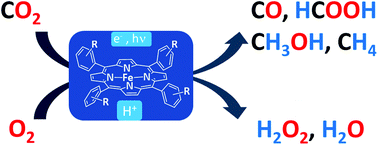
Dalton Trans., 2019,48, 5869-5878
https://doi.org/10.1039/C9DT00136K
Recent advances in bioinspired proton-coupled electron transfer
Fundamental aspects of PCET continue to attract attention. Understanding this reaction type is desirable for small-molecule activation and solar energy conversion.
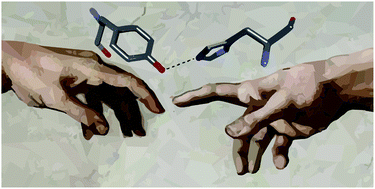
Dalton Trans., 2019,48, 5861-5868
https://doi.org/10.1039/C8DT04373F
Coordination-induced structural changes of DNA-based optical and electrochemical sensors for metal ions detection
This article highlights the coordination-induced structural changes of DNA-based optical, electrochemical and optical–electrochemical-combined sensors for metal ions detection.
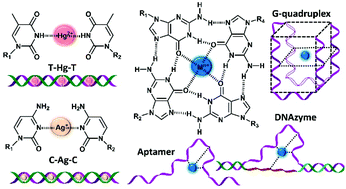
Dalton Trans., 2019,48, 5879-5891
https://doi.org/10.1039/C8DT04733B
Transfer of hydrosulfide from thiols to iron(II): a convenient synthetic route to nonheme diiron(II)–hydrosulfide complexes
The synthesis and reactivity of an unprecedented nonheme diiron(II)–hydrosulfide complex via Fe(II) mediated C–S bond cleavage of thiols.
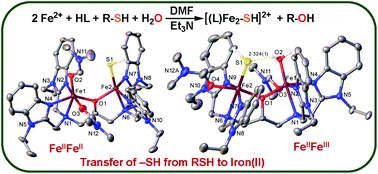
Dalton Trans., 2019,48, 5903-5908
https://doi.org/10.1039/C8DT04092C
Transformation of the hydride-containing dinitrosyl iron complex [(NO)2Fe(η2-BH4)]− into [(NO)2Fe(η3-HCS2)]−via reaction with CS2
Hydride-insertion reactivity of DNIC [(NO)2Fe(η2-BH4)]− promotes the reductive transformation of CS2 into DNIC [(NO)2Fe(η3-HCS2)]− featuring Fe 3dz2-to-HCS2 π* backbonding interaction.
![Graphical abstract: Transformation of the hydride-containing dinitrosyl iron complex [(NO)2Fe(η2-BH4)]− into [(NO)2Fe(η3-HCS2)]−via reaction with CS2](/en/Image/Get?imageInfo.ImageType=GA&imageInfo.ImageIdentifier.ManuscriptID=C8DT04714F&imageInfo.ImageIdentifier.Year=2019)
Dalton Trans., 2019,48, 5897-5902
https://doi.org/10.1039/C8DT04714F
Biophysical analysis of cancer stem cell-potent copper(II) coordination complexes
Copper(II) coordination complexes, 1 and 2, containing nonsteroidal anti-inflammatory drugs (NSAIDs) potently kill breast cancer stem cells (CSCs) and bulk breast cancer cells.
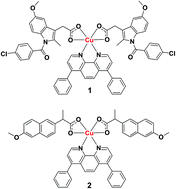
Dalton Trans., 2019,48, 5892-5896
https://doi.org/10.1039/C8DT04706E
G-Quadruplex binding optimization by gold(III) insertion into the center of a porphyrin
Gold(III) porphyrins have a square planar geometry and an extra positive charge, compatible with stronger electrostatic and π-stacking interactions.
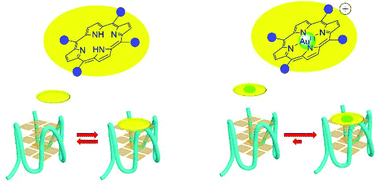
Dalton Trans., 2019,48, 6091-6099
https://doi.org/10.1039/C8DT04703K
Restricted rotation of an Fe(CO)2(PL3)-subunit in [FeFe]-hydrogenase active site mimics by intramolecular ligation
Terminal ligand fixation by covalent linkage to the bridging bdt ligand hinders ligand rotations.
![Graphical abstract: Restricted rotation of an Fe(CO)2(PL3)-subunit in [FeFe]-hydrogenase active site mimics by intramolecular ligation](/en/Image/Get?imageInfo.ImageType=GA&imageInfo.ImageIdentifier.ManuscriptID=C8DT05148H&imageInfo.ImageIdentifier.Year=2019)
Dalton Trans., 2019,48, 5933-5939
https://doi.org/10.1039/C8DT05148H
Structure of sirohydrochlorin ferrochelatase SirB: the last of the structures of the class II chelatase family
The crystal structure of sirohydrochlorin ferrochelatase SirB was finally unveiled toward a consideration of the structural diversity of class II chelatases.
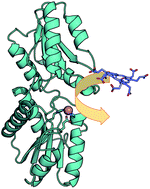
Dalton Trans., 2019,48, 6083-6090
https://doi.org/10.1039/C8DT04727H
Biliverdin–copper complex at physiological pH
In physiological settings, biliverdin and Cu2+ build a paramagnetic complex with formal structure: radical cation/Cu1+ or radical anion/Cu3+.
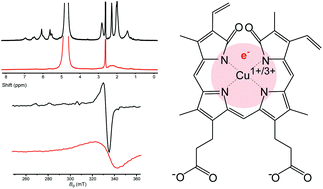
Dalton Trans., 2019,48, 6061-6070
https://doi.org/10.1039/C8DT04724C
In vitro cytotoxicity and in vivo zebrafish toxicity evaluation of Ru(II)/2-mercaptopyrimidine complexes
Ru(II)/2-mercaptopyrimidine complexes active against cancer cells did not present toxic effects during embryonic and larval development of zebrafish.
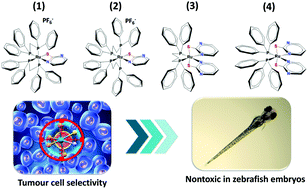
Dalton Trans., 2019,48, 6026-6039
https://doi.org/10.1039/C8DT03738H
Hydrogenase biomimics containing redox-active ligands: Fe2(CO)4(μ-edt)(κ2-bpcd) with electron-acceptor 4,5-bis(diphenylphosphino)-4-cyclopenten-1,3-dione (bpcd) as a potential [Fe4–S4]H surrogate
The diiron centre and redox-active diphosphine are reduced in separate steps but there is little evidence of intramolecular electron transfer between the two.
![Graphical abstract: Hydrogenase biomimics containing redox-active ligands: Fe2(CO)4(μ-edt)(κ2-bpcd) with electron-acceptor 4,5-bis(diphenylphosphino)-4-cyclopenten-1,3-dione (bpcd) as a potential [Fe4–S4]H surrogate](/en/Image/Get?imageInfo.ImageType=GA&imageInfo.ImageIdentifier.ManuscriptID=C8DT04906H&imageInfo.ImageIdentifier.Year=2019)
Dalton Trans., 2019,48, 6051-6060
https://doi.org/10.1039/C8DT04906H
Molybdenum dinitrogen complex supported by a cyclohexane-based triphosphine ligand and dmpm
We report the first molybdenum dinitrogen complex supported by a cyclohexane-based triphosphine ligand.
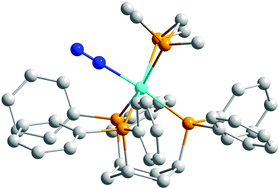
Dalton Trans., 2019,48, 6019-6025
https://doi.org/10.1039/C8DT04738C
Tuning a robust system: N,O zinc guanidine catalysts for the ROP of lactide
Four non-toxic, highly active and robust complexes have been used in the ring opening polymerisation of non-purifed lactide to substitute Sn(Oct)2.
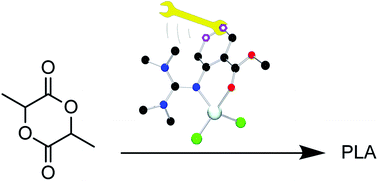
Dalton Trans., 2019,48, 6071-6082
https://doi.org/10.1039/C8DT04938F
Insight into chalcogenolate-bound {Fe(NO)2}9 dinitrosyl iron complexes (DNICs): covalent character versus ionic character
The synthesis, characterization and transformation of the thermally unstable {Fe(NO)2}9 dinitrosyl iron complex (DNIC) [(OMe)2Fe(NO)2]− (2) were investigated.
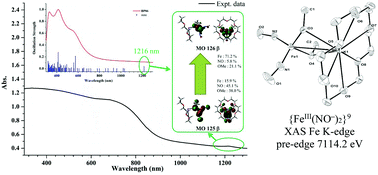
Dalton Trans., 2019,48, 6040-6050
https://doi.org/10.1039/C8DT04670K
The interaction of aluminum with catecholamine-based neurotransmitters: can the formation of these species be considered a potential risk factor for neurodegenerative diseases?
What are the molecular basis of the detrimental role of the aluminum ion within the catecholamine biosynthesis pathway?
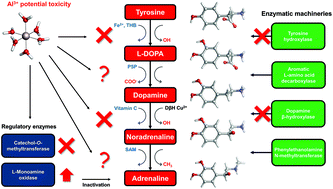
Dalton Trans., 2019,48, 6003-6018
https://doi.org/10.1039/C8DT04216K
Physical properties, ligand substitution reactions, and biological activity of Co(III)-Schiff base complexes
A subset of fluorinated Co(III) Schiff base complexes was synthesized, and their structural, ligand exchange, and anticancer properties were investigated.
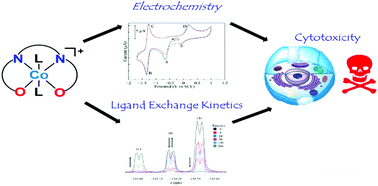
Dalton Trans., 2019,48, 5987-6002
https://doi.org/10.1039/C8DT04606A
Dinuclear manganese(III) complexes with bioinspired coordination and variable linkers showing weak exchange effects: a synthetic, structural, spectroscopic and computation study
High-resolution HFEPR indicates weak exchange interactions between MnIII ions in agreement with DFT calculations.
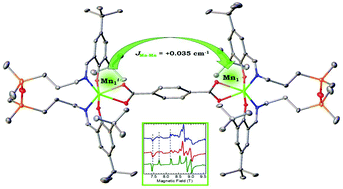
Dalton Trans., 2019,48, 5909-5922
https://doi.org/10.1039/C8DT04596H
Monitoring H-cluster assembly using a semi-synthetic HydF protein
An artificial enzyme, incorporating an organometallic iron complex, is used to probe the activation mechanism of [FeFe] hydrogenase.

Dalton Trans., 2019,48, 5978-5986
https://doi.org/10.1039/C8DT04294B
Sulfur substitution in a Ni(cyclam) derivative results in lower overpotential for CO2 reduction and enhanced proton reduction
N/S replacement in Ni-cyclam complexes highlights the importance of biologically relevant sulfur ligands in the CO2 and proton reduction.

Dalton Trans., 2019,48, 5923-5932
https://doi.org/10.1039/C8DT04740E
Role of 2nd sphere H-bonding residues in tuning the kinetics of CO2 reduction to CO by iron porphyrin complexes
A series of iron porphyrins that vary only in the distal H-bonding network exhibit turnover frequencies (TOFs) ranging from 1.0 s−1 to 103 s−1.
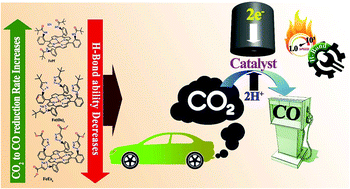
Dalton Trans., 2019,48, 5965-5977
https://doi.org/10.1039/C8DT03850C
Synthesis, structure, docking and cytotoxic studies of ferrocene–hormone conjugates for hormone-dependent breast cancer application
Ferrocene–estrogen conjugates can be recognized by ERα, suggesting that estrogens could serve as vectors to target specifically breast cancer cell lines.
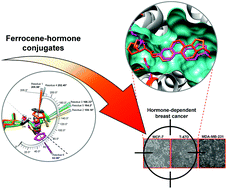
Dalton Trans., 2019,48, 5952-5964
https://doi.org/10.1039/C8DT01856A
Mesoporous silica nanoparticles functionalised with a photoactive ruthenium(II) complex: exploring the formulation of a metal-based photodynamic therapy photosensitiser
A ruthenium(II) complex was loaded onto mesoporous silica nanoparticles and the phototherapeutic activity of the materials was tested in cancer cells.
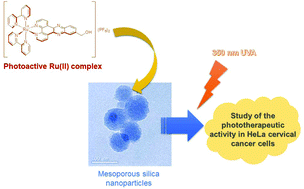
Dalton Trans., 2019,48, 5940-5951
https://doi.org/10.1039/C8DT02392A
About this collection
Coordination chemistry plays a fundamental role in many biological processes, from respiration and photosynthesis to protein folding. Biological systems exhibit formidable control over reactivity through the choice of metal, coordinating ligand set, and redox environment. The diversity offered by biological coordination chemistry has inspired inorganic chemists amongst others to design and develop a multitude of small molecule biomimetics for various applications, and study biological processes using inorganic tools. Guest edited by Kogularamanan Suntharalingam and Ulf-Peter Apfel, this themed issue seeks to highlight the area of bioinspired reactivity and coordination chemistry.